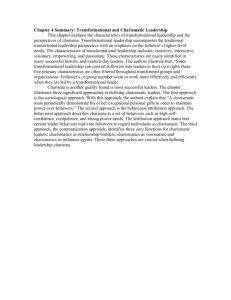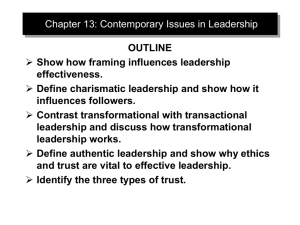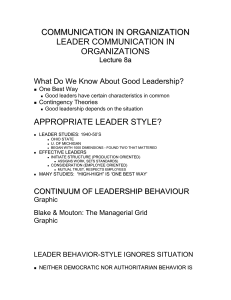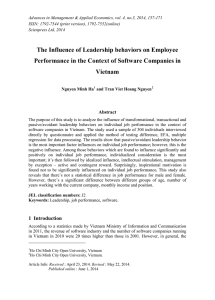Consequences of Charismatic Leadership
advertisement
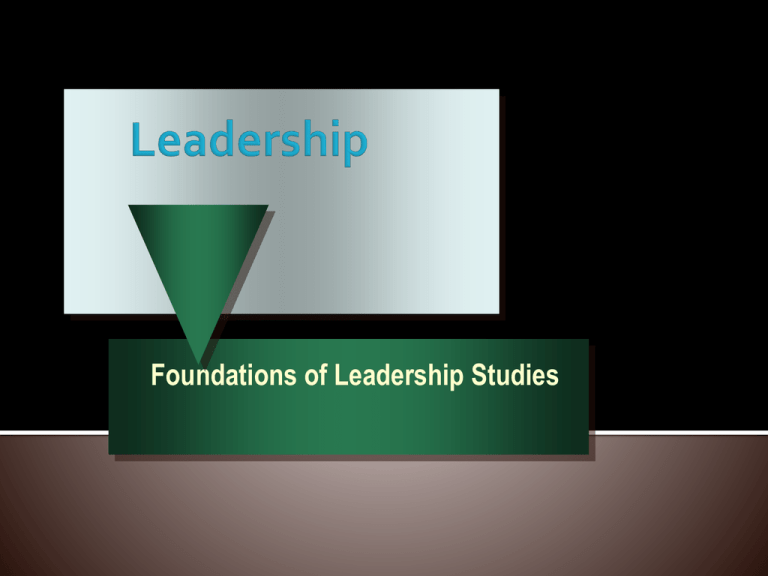
Foundations of Leadership Studies Charismatic Leadership Transactional leadership Transformational Leadership Followers make attributions of heroic or extraordinary leadership abilities when they observe certain behaviors People working for charismatic leaders are motivated to exert extra work effort and, because they like and respect their leaders, express greater satisfaction Charisma leadership appears to be most appropriate when the followers’ task has a ideological component or when the environment involves a high degree of stress and uncertainty 1. Vision and articulation. Has a vision—expressed as an idealized goal— that proposes a future better than the status quo; and is able to clarify the importance of the vision in terms that are understandable to others. 2. Personal risk. Willing to take on high personal risk, incur high costs and engage in self-sacrifice to achieve the vision. 3. Environmental sensitivity. Able to make realistic assessments of the environmental constraints and resources needed to bring about change. 4. Sensitivity to follower needs. Perceptive of others’ abilities and responsive to their needs and feelings. 5. Unconventional behavior. Engages in behaviors that are perceived as novel and counter to norms. Level 5 Leaders Possess a fifth dimension—a paradoxical blend of personal humility and professional will—in addition to the four basic leadership qualities of individual capability, team skills, managerial competence, and the ability to stimulate others to high performance. Channel their ego needs away from themselves and into the goal of building a great company. Positive and Negative Charismatics Determined by examining the consequences for followers Negative charismatics have a personalized power orientation Positive charismatics have a socialized power orientation Being in awe of the leader reduces good suggestions by followers Desire for leader acceptance inhibits criticism by followers Adoration by followers creates delusions about the leader Excessive confidence and optimism blind the leader to real dangers Denial of problems and failures reduces organizational learning Risky, grandiose projects are more likely to fail Taking complete credit for successes alienates some key followers Impulsive, nontraditional behavior creates enemies Dependence on the leader inhibits development of competent successors Failure to develop successors creates an eventual leadership crisis Transactional and Transformational Leadership Transformational Leadership Transformational leadership appeals to the moral values of followers to raise their consciousness and mobilize their energies Transactional leadership motivates followers by appealing to their self-interest and exchanging benefits Transactional Leaders • Contingent Reward Leaders who guide or motivate their followers in the direction of established goals by clarifying role and task requirements. • Management by Exception (active) Transformational Leaders Leaders who provide the four “I’s” (individualized consideration, inspirational motivation, idealized influence, and intellectual stimulation) • Management by Exception (passive) • Laissez-Faire • Idealized Influence • Inspirational Motivation • Intellectual Stimulation • Individual Consideration Contingent Reward: Contracts exchange of rewards for effort, promises rewards for good performance, recognizes accomplishments. Management by Exception (active): Watches and searches for deviations from rules and standards, takes corrective action. Management by Exception (passive): Intervenes only if standards are not met. Laissez-Faire: abdicates responsibilities, avoids making decisions. KEEPS THE SYSTEM OPERATING SMOOTHLY USES REWARD AND COERCIVE POWER BASES RECOGNIZES WHAT WORKERS WANT & TRIES TO DELIVER IT REWARDS ACCORDING TO WORKER EFFORT RESPONSIVE TO WORKER SELF-INTERESTS Idealized Influence: Provides vision and sense of mission, instills pride, gains respect and trust. Inspiration: Communicates high expectations, uses symbols to focus efforts, expresses important purposes in simple ways. Intellectual Stimulation: Promotes intelligence, rationality, and careful problem solving. Individualized Consideration: Gives personal attention, treats each employee individually, coaches, advises. INSPIRATIONAL, IDEA-ORIENTED, VISIONARY DRAMATIC, AROUSES INTENSE FEELINGS COMMUNICATES HIGH EXPECTATIONS & A NEED FOR CHANGE UNPREDICTABLE RELIES ON REFERENT OR CHARISMATIC POWER RAISES LEVEL OF AWARENESS AND COMMITMENT GETS FOLLOWERS TO TRANSCEND THEIR SELF-INTERESTS REQUIRES TRUST AND BELIEF IN THE VISION PRESENTED IS TRANSFORMATIONAL LEADERSHIP BUILT “ON TOP OF” TRANSACTIONAL LEADERSHIP, OR IS IT JUST A SPECIAL CASE OF CHARISMATIC LEADERSHIP? Facilitating Conditions Some aspects of transformational leadership are relevant in most, if not all, situations Dynamic, unstable environment that increases the need for change Leaders are encouraged to be flexible and innovative Follower traits and values Articulate a clear and appealing vision Explain how the vision can be attained Act confident and optimistic Express confidence in followers Use dramatic, symbolic actions to emphasize key values Lead by example


